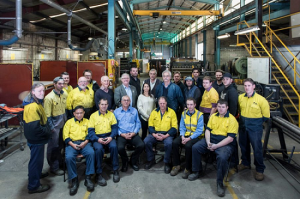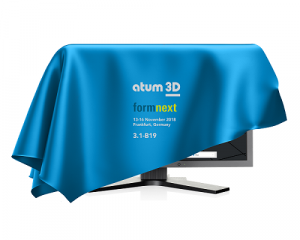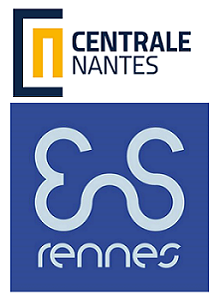3D Printing News Briefs: October 31, 2018
Happy Halloween, fair readers! We’re giving you a treat today instead of a trick – our latest edition of 3D Printing News Briefs. First up, Materialise has completed a mammoth 3D printing project, and Australian manufacturing company C-Mac is embracing the technology for the first time. atum3D has revealed what new product it will be bringing to the upcoming formnext 2018. Finally, a group of French researchers compared powder bed fusion and binder jet 3D printing as possible methods for fabricating sand molds.
Materialise Unveils Life-Size 3D Printed Mammoth
 The massive Mammoth of Lier, named for the Belgian city where it was discovered, lived during 20,000 BC, and has been on display at the Royal Belgian Institute of Natural Sciences in Brussels since 1869. But thanks to the hard work of Belgian 3D printing company Materialise, the woolly mammoth skeleton is now back home in Lier…a 3D printed version of it, anyway. Earlier this summer, a multidisciplinary team of Materialise engineers and production operators, paleontologists, and archaeologists began work on the mammoth 3D printing project, which is Materialise’s largest yet at 3.5 meters tall. Materialise optimized the 3D scans of each of the mammoth’s 320 bones in order to replicate its fossilized skeleton, then digitally reconstructed it and prepared each file for 3D printing.
The massive Mammoth of Lier, named for the Belgian city where it was discovered, lived during 20,000 BC, and has been on display at the Royal Belgian Institute of Natural Sciences in Brussels since 1869. But thanks to the hard work of Belgian 3D printing company Materialise, the woolly mammoth skeleton is now back home in Lier…a 3D printed version of it, anyway. Earlier this summer, a multidisciplinary team of Materialise engineers and production operators, paleontologists, and archaeologists began work on the mammoth 3D printing project, which is Materialise’s largest yet at 3.5 meters tall. Materialise optimized the 3D scans of each of the mammoth’s 320 bones in order to replicate its fossilized skeleton, then digitally reconstructed it and prepared each file for 3D printing.
“When I heard that the mammoth of Lier would be 3D-printed, I was amazed. 3D printing has already been used for reproducing missing bones, but here we were talking about an entire mammoth, and I think it’s the first time this has been achieved,” said Dr. Mietje Germonpré, paleontologist at the Royal Belgian Institute of Natural Sciences in Brussels. “3D printing gave us the opportunity to create a new, more scientifically accurate reconstruction of the mammoth’s anatomy.”
Fittingly, Materialise used nine of its large-format Mammoth SLA 3D printers, the only machines it makes but does not sell, to complete all 1,260 hours of 3D printing. The company’s Design & Engineering team also created a modular carbon fiber structure that could support the skeleton from the interior. Now, the 3D printed replica of the mammoth is back in Lier, just in time for the doors to open at its new city museum.
C-Mac Embraces 3D Printing
 Australian manufacturing company C-Mac Industries Cooperative Ltd, headquartered in Sydney, recognized that times were changing in the industry, and not exactly for the better. Between 2008 and 2013, the country lost one manufacturing job every 19 minutes, and C-Mac realized that it needed to evolve. So in the middle of 2017, all of the staff members agreed to become business owners, and C-Mac went from being a family-owned company to a more socially responsible workers’ co-operative. In order to sustain and keep growing its business, C-Mac spent a ten-month period adopting 3D printing and creating parts for over ten different industries, as the technology is rapidly becoming a preferred approach to developing product models.
Australian manufacturing company C-Mac Industries Cooperative Ltd, headquartered in Sydney, recognized that times were changing in the industry, and not exactly for the better. Between 2008 and 2013, the country lost one manufacturing job every 19 minutes, and C-Mac realized that it needed to evolve. So in the middle of 2017, all of the staff members agreed to become business owners, and C-Mac went from being a family-owned company to a more socially responsible workers’ co-operative. In order to sustain and keep growing its business, C-Mac spent a ten-month period adopting 3D printing and creating parts for over ten different industries, as the technology is rapidly becoming a preferred approach to developing product models.
“You have to embrace change,” said C-Mac’s General Manager Steve Grlyak. ” We have seen so many manufacturing companies in Sydney go bankrupt because they are not willing to change or are slow to adapt to change or have over capitalised on the wrong equipment.
“It is only the beginning. We are also looking into having a 3d printing scholarship award to provide help to students in Australia along with striving to build a bridge between knowledge and practice. The future is upon us.”
It’s not easy to adopt a new type of thinking, but C-Mac knew that 3D printing was the future of the industry and, with the help of its 50 years of experience in manufacturing, stepped up to the plate.
atum3D Introducing Latest Software at formnext
 At the upcoming formnext 2018, open platform DLP 3D printing specialist atum3D will be introducing its new, redesigned Operator Station software, which comes with proprietary MAGS AI technology. Thanks to an intuitive user interface and touchscreen support, the software makes it easy for users to prepare print jobs for the company’s DLP Station 3D printers. Operator Station lets users duplicate parts, or fill available build volume, with the click of a button, and its MAGS AI will automatically adjust a part’s orientation and generate the necessary supports.
At the upcoming formnext 2018, open platform DLP 3D printing specialist atum3D will be introducing its new, redesigned Operator Station software, which comes with proprietary MAGS AI technology. Thanks to an intuitive user interface and touchscreen support, the software makes it easy for users to prepare print jobs for the company’s DLP Station 3D printers. Operator Station lets users duplicate parts, or fill available build volume, with the click of a button, and its MAGS AI will automatically adjust a part’s orientation and generate the necessary supports.
“We’re very excited to be back in Frankfurt for the third time in a row to show our most recent developments. This year, the main spotlight is on software, one of the three pillars on which atum3D was built, together with hardware engineering and resin chemicals. When creating the all new Operator Station software from the ground up, we took special care to incorporate our user’s feedback and requests. That’s why we created a highly intuitive interface that takes you from part import to final print job in just a few clicks. The intelligent approach of our proprietary MAGS AI technology, which is the abbreviation of Mark, Adjust & Generate Supports, plays an essential role,” said Tristram Budel, CEO at atum3D.
““MAGS AI now analyses the part’s shape, keeps my selection free of supports, suggests the optimal orientation and adds the necessary supports. That’s about as fast and easy as it gets!”
At formnext, atum3D will also be introducing its new Industry Excellence Pack for material scientists and research institutes, as well as an open resin platform for the DLP Station 5, which will be showcased at the event. Visit atum3D at booth 3.1-B19 to see its new Operator Station with MAGS AI and the DLP Station 5.
Comparing Powder Bed Fusion and Binder Jetting for Sand Molds
 A trio of researchers from Centrale Nantes and École Normale Supérieure de Rennes in France recently published a paper, titled “A review on the additive manufacturing of sand molds by binder jetting and selective laser sintering,” that analyzes the current techniques of the casting industry for using 3D printed sand molds. Specifically, they looked at SLS and binder jet 3D printing. In the paper, the researchers analyzed patents, case studies, and scientific articles, as there is limited data about 3D printed sand molds in other studies. The research team got together because there’s a lack of resources and interest in 3D printing sand molds, and they wanted to provide a more comprehensive analysis of the topic. The paper highlighted the current gaps in the field, as well as proposed some key perspectives for possible social implications.
A trio of researchers from Centrale Nantes and École Normale Supérieure de Rennes in France recently published a paper, titled “A review on the additive manufacturing of sand molds by binder jetting and selective laser sintering,” that analyzes the current techniques of the casting industry for using 3D printed sand molds. Specifically, they looked at SLS and binder jet 3D printing. In the paper, the researchers analyzed patents, case studies, and scientific articles, as there is limited data about 3D printed sand molds in other studies. The research team got together because there’s a lack of resources and interest in 3D printing sand molds, and they wanted to provide a more comprehensive analysis of the topic. The paper highlighted the current gaps in the field, as well as proposed some key perspectives for possible social implications.
“The review investigates new factors and methods for mold design, looking at mechanical properties and cost analysis as influenced by material selection, thermal characteristics, topological optimization and manufacturing procedure,” the researchers state in the paper. “Findings in this study suggest that this topic lacks vigorous scientific research and that the case studies by manufacturers thus far are not useful.”
Co-authors of the paper are Tugdual Amaury Le Néel, Pascal Mognol, and Jean-Yves Hascoët.
Discuss these stories and other 3D printing topics at 3DPrintBoard.com or share your thoughts in the comments below.
Naval Group and Centrale Nantes Create First 3D Printed Military Propeller Blade
3D printing is making an impact on the maritime industry, which is no small feat considering the number of regulations involved in making anything that can actually be used in the industry. So it was quite a task that a group of partners accomplished when they introduced the WAAMpeller, the world’s first class-approved 3D printed ship’s propeller, last year. The WAAMpeller was created using Wire and Arc Additive Manufacturing, or WAAM, a fast, inexpensive hybrid method of 3D printing.
 The WAAMpeller now has some competition in the arena of 3D printed propeller fame. Naval Group, a French industrial group that specializes in naval defense and marine renewable energy, has partnered with fellow French institution Centrale Nantes, a school that has worked with WAAM itself in the past, to create the first full-scale 3D printed propeller blade demonstrator for military applications. The large, complex propeller blade weighs more than 300 kg and paves the way for the manufacture of more geometrically complex propellers in the future.
The WAAMpeller now has some competition in the arena of 3D printed propeller fame. Naval Group, a French industrial group that specializes in naval defense and marine renewable energy, has partnered with fellow French institution Centrale Nantes, a school that has worked with WAAM itself in the past, to create the first full-scale 3D printed propeller blade demonstrator for military applications. The large, complex propeller blade weighs more than 300 kg and paves the way for the manufacture of more geometrically complex propellers in the future.
“Printing this demonstrator is a major step towards the manufacture of innovative propellers by additive manufacturing,” said Vincent Geiger, Director of Naval Group’s Naval Research Technology Research Center. “These initial results mean that it’s possible to envisage the short-term commissioning of differentiated propellers for the ships that will use them.”
 The 3D printed propeller blade is another example of a part that could not have been made with more traditional manufacturing processes. By allowing for more innovative designs, additive manufacturing enables naval components that are more efficient, with more autonomy, better propulsion, strength and lightening.
The 3D printed propeller blade is another example of a part that could not have been made with more traditional manufacturing processes. By allowing for more innovative designs, additive manufacturing enables naval components that are more efficient, with more autonomy, better propulsion, strength and lightening.
“Additive manufacturing is a process that offers unlimited possibilities: less material used, integration of additional features and geometrically-complex parts assembly,” said Professor Jean-Yves Hascoët, who heads up the Rapid Manufacturing Platform at Centrale Nantes, in the GeM laboratory (UMR CNRS 6183). “It allows for new designs, weight savings, lower manufacturing costs.”
Naval Group is the European leader in naval defense, with a presence in 18 countries. The company designs, produces and supports both submarines and surface ships, and provides services for naval shipyards and bases. It also offers a wide range of marine renewable energy solutions.
Centrale Nantes was founded in 1919 and trains engineers in the scientific and technical skills they need to make an impact in the workforce. The school has a strong program in additive manufacturing, and is involved in other research into additive manufacturing and naval applications, including propellers. Its industrial capabilities and expertise in trajectory generation and additive manufacturing make it a valuable partner on this latest project.
From submarine hulls to replacement parts, 3D printing is making its presence known in the naval and marine sectors. The appeal of the technology is the same as it is in other industries such as aerospace and automotive: it’s faster, less expensive, and can create novel geometries with capabilities beyond anything that can be created using conventional manufacturing techniques. Additive manufacturing often results in much more lightweight components, which enable ships, planes and automobiles to be speedier and more efficient, saving both money and energy.
Discuss this and other 3D printing topics at 3DPrintBoard.com or share your thoughts below.

